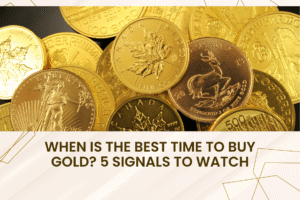Gold has captivated humanity for millennia. Its unmistakable shine has been a symbol of wealth, power, and prosperity across cultures and centuries. From the golden burial mask of Tutankhamun to the bullion reserves of modern central banks, gold has always represented more than just metal – it represents trust.
But what makes gold truly valuable? Why has it maintained its worth while currencies have collapsed, empires have fallen, and technologies have changed the world? In this article, we’ll break down the key reasons gold continues to be a globally trusted store of value and a pillar in investment portfolios.
—
Scarcity: Gold Is Rare by Nature
Gold’s value starts with its rarity. Unlike fiat currency which governments can print at will, gold is limited. It must be physically mined from the Earth’s crust, often at great effort and cost.
To give perspective:
- All the gold ever mined in human history could fit into a cube roughly 23 meters (75 feet) on each side.
- New gold discoveries have been declining in recent years, while demand (especially from investors and central banks) has risen.
This natural scarcity gives gold intrinsic value. It’s not man-made, and it can’t be conjured out of thin air.
—
Durability: Gold Never Dies
Gold is chemically one of the most stable elements. It doesn’t rust, tarnish, or decay – unlike silver, iron, or copper. That’s why ancient gold coins, jewelry, and artifacts can still be found in pristine condition thousands of years after they were buried.
This makes gold the ultimate symbol of permanence. If you buy a gold coin today and store it properly, it will look exactly the same 100 years from now. This kind of physical durability contributes to its reputation as a safe and long-term store of value.
—
Universally Recognized and Trusted
Gold is accepted across every country, religion, and economic system. Whether you’re in Dubai, Delhi, London, or Tokyo, gold is understood as valuable. It transcends language, borders, and even technology.
This universal acceptance is rooted in:
- Its long history as money – gold coins were used in trade from the Roman Empire to the Ottoman Empire.
- Its role in global banking – gold was once the backbone of the global monetary system under the Gold Standard.
- Its continued use in jewelry and religious ceremonies across many cultures.
—
Inflation Hedge and Safe Haven Asset
One of the most practical reasons people value gold is its performance during economic downturns and inflation. When the value of paper currencies declines due to excessive money printing or geopolitical instability, gold often maintains or increases its value.
Here’s why:
- Gold is priced globally in U.S. dollars. When the dollar weakens, gold prices usually rise.
- In times of crisis (wars, recessions, pandemics), investors shift to “safe haven” assets like gold, which historically perform better than stocks or fiat currencies.
—
Tangible, Portable, and Private
Unlike digital assets or bank account balances, gold is physical. You can hold it in your hand, store it in a safe, or pass it down to future generations.
This tangibility offers benefits:
- No counterparty risk: Gold doesn’t rely on a company, government, or blockchain to retain value.
- Private and portable: You don’t need a password to access gold and a few coins can carry thousands of dollars in value.
In a world of increasing surveillance and digital exposure, the privacy and simplicity of gold appeal to both traditionalists and modern investors alike.
—
Cultural, Symbolic, and Emotional Value
Gold is deeply woven into human culture. In many societies, it goes beyond wealth. It represents beauty, luck, and tradition.
- In India, gold is considered auspicious and plays a vital role in weddings and festivals.
- In the Middle East, gold jewelry is often bought for newborns and as bridal gifts.
- Across Asia and Africa, gold is passed down as a symbol of family legacy and honor.
This emotional and symbolic connection helps sustain demand for gold beyond market logic. It’s not just an asset, it’s a tradition.
—
Used in More Than Just Jewelry
While much of the world’s gold is used in jewelry, a surprising amount is also used in:
- Electronics: gold is highly conductive and resists corrosion, making it ideal for phones, circuit boards, and medical devices.
- Aerospace: gold reflects radiation and is used in satellite and space tech.
- Dentistry and medicine: gold compounds are used in some treatments and implants.
These industrial uses help support demand, reinforcing its market value.
—
Conclusion
Gold’s value is rooted in far more than its glitter. It’s rare, durable, culturally significant, and universally trusted. It has survived currency collapses, political revolutions, and stock market crashes and continues to play a critical role in both personal and institutional wealth strategies.
Whether you’re wearing it, gifting it, or storing it in a vault, gold remains one of the most timeless and reliable assets in the world.




